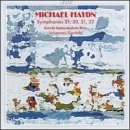| All Artists: Michael Haydn, Johannes Goritzki, Deutsche Kammerakademie Neuss Title: Michael Haydn: Symphonies 21, 30, 31, 32 Members Wishing: 0 Total Copies: 0 Label: Cpo Records Release Date: 9/17/1996 Genre: Classical Styles: Historical Periods, Classical (c.1770-1830), Symphonies Number of Discs: 1 SwapaCD Credits: 1 UPC: 761203917921 |
Search - Michael Haydn, Johannes Goritzki, Deutsche Kammerakademie Neuss :: Michael Haydn: Symphonies 21, 30, 31, 32
 | Michael Haydn, Johannes Goritzki, Deutsche Kammerakademie Neuss Michael Haydn: Symphonies 21, 30, 31, 32 Genre: Classical
|
Larger Image |
CD Details |
CD ReviewsInteresting Symphonies from the "Other" Haydn M. C. Passarella | Lawrenceville, GA | 11/11/2009 (5 out of 5 stars) "I have to confess that despite the fact that I collect on CD and casually study the works of the more prominent symphonists (other than Joseph Haydn and Mozart) of the 18th century, they do seem to run together after a bit, and sometimes it gets hard to distinguish one from another. There are, of course, those occasional symphonists who sound like no other (C. P. E. Bach being a good example), and in his mature symphonies, Michael Haydn, too, creates a unique sound world that sets him apart. As the notes to the current recording assert, this is because Michael, like older brother Joseph, approached the symphony experimentally. A case in point is Michael's Symphony No. 18 (Perger 10) written in 1773 and scored for two English horns, two pifferi, three bassoons, and tamburo, along with the usual strings and oboes--a very unusual work, which I highly recommend. If you can find the Vox Box of Michael's symphonies recorded by Harold Farberman, you'll get this symphony along with other memorable music. There's nothing quite as unusual on the current CPO CD, but Symphonies Nos. 31 and 32 are unique in their own right. No. 31 features a slow movement with concerto-like solos for English horn and violin, while No. 32 has just two movements, both fast, the only two-movement symphony among Michael's forty-three such works. It's a festive piece--with trumpets and drums and athletic solos for the flute--that apparently served as a birthday offering for the archbishop of Salzburg, where Michael lived and worked as Kapellmeister for over forty years. In addition to the more atypical features of these works, Nos. 21 and 30 are among a handful of Michael's symphonies that start with a slow introduction--a very different case from Joseph's. Except for Symphony No. 21 of 1778, the symphonies on this CPO disc are from the 1780s and are examples of Michael's fully mature symphonic style. They're characterized by fast movements built on pleasantly bustling, folksy-sounding themes with odd little turns of phrase; often plangent slow movements; and, in No. 31, the unusual coloration provided by two English horns. Goritsky's performances are fine, spirited ones, and the playing of his orchestra is sure and deft. This is a very good way to get to know one of the 18th century's more interesting symphonists." Review of J.M. Haydn symphonies 21,30,31,32 William E. Haymes | 07/20/2007 (5 out of 5 stars) "This CD of J. M. Haydn's syphonies 21, 30,31, and 32 is one of the best. For music lovers who enjoy Mozart and F. J. Haydn this is a treat."
|

 Track Listings (11) - Disc #1
Track Listings (11) - Disc #1